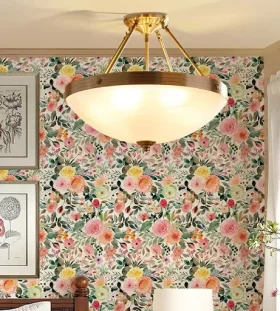The Longevity of Peel-and-Stick Wallpaper: A Comprehensive Guide

Text Leading
Peel-and-stick wallpaper offers a fresh and flexible approach to home décor. Ideal for renters, DIY lovers, and those constantly evolving their interior tastes, this self-adhesive solution provides an easy-to-apply, cost-effective, and damage-free alternative to traditional wall treatments. Dive into the world of this innovative decorating tool and learn about the lifespan of peel-and-stick wallpaper and the factors that affect its longevity.
Introduction
The eternal quest to spruce up your living space without the mess of traditional wallpaper or paint. Enter the Peel-and-Stick Wallpaper. These wallpapers are particularly favored by renters, DIY enthusiasts, and those who often change their design preferences, as they can be easily installed and removed without causing damage to walls. Investing in home decoration is not only about aesthetics, but also about cost-effectiveness. So the longevity of peel-and-stick wallpaper is critical to both homeowners and renters.
What is Peel-and-Stick Wallpaper?
Peel-and-stick wallpaper is essentially a self-adhesive wall covering that’s designed for easy application and removal. Think of it as a giant sticker for your wall. The adhesive side is protected by a backing that you peel off as you apply the paper to your desired surface. This innovation in home decor has eliminated the need for glue, pastes, or any additional adhesives. Its main feature is its versatility. It is not limited to bedroom walls, but also applied to furniture and even ceilings. This opens up a plethora of creative decorating options.
Traditional wallpaper usually requires a paste or adhesive to apply. Once wallpaper is in place, removing or replacing it can be quite a challenge. Peel-and-stick wallpaper is easy to create compared to traditional wallpaper. Almost anyone can complete the installation. There is minimal mess and removal is as easy as peeling it off the wall, leaving minimal residue.
Use of Peel-and-Stick Wallpaper in different scenarios
- Home Renovations on a Budget
When working within a tight budget for home renovations, peel-and-stick wallpaper can be a godsend. Instead of investing in expensive tiles or paints, homeowners can opt for tile stickers, especially for areas like the kitchen backsplash or bathroom walls. It is not only oil-resistant, mildew-resistant, and easy to clean, just wipe clean.
For larger areas, like living rooms or bedrooms, large sheets of wall stickers can transform the ambiance. Whether you’re looking to create a feature wall with a bold pattern or just add a touch of texture, these wall stickers offer the flexibility of choice without a long-term commitment or hefty price tag.
- Temporary Housing or College Dorms
For those in temporary housing situations or college dorms, personalizing space is essential, but there’s always the challenge of not making permanent changes. Large sheets of wall stickers can help create a homey feel, from serene landscapes to motivational quotes, helping these temporary spaces feel more like “home.”
- Changing Kid’s Room Themes
Children’s rooms are always evolving, reflecting their changing interests and ages. Instead of permanent decorations, peel-and-stick wallpapers, especially large wall stickers with their favorite characters or themes, can be employed. As they grow, these can be easily swapped out for more age-appropriate designs.

Factors Affecting Longevity
- Material quality
Material quality is paramount when determining the lifespan of peel-and-stick wallpapers. Higher quality materials not only ensure a smoother application but also enhance durability. Top-tier wallpapers are often made from vinyl or a blend of high-quality fabrics, which can resist wear and tear, fading, and even minor scuffs. On the other hand, cheaper alternatives may seem tempting but can be prone to rips, bubbles, and early peeling. Therefore, when choosing wallpaper, higher quality products can save you time and money by reducing the need for frequent replacements.
- Environmental factors like humidity and temperature
The environment plays a significant role in the longevity of wallpapers. Peel-and-stick wallpaper exposed to high humidity, such as in bathrooms or kitchens, can lose their its adhesive quality over time. And wallpapers in rooms with large temperature fluctuations may have loose adhesive, causing the corners to peel off or the entire wallpaper to fall off.
- Surface preparation
The foundation of peel-and-stick wallpaper is also an important part of its service life. A clean, dry, and smooth surface ensures optimal adherence. Any residue, dirt, or texture can compromise the bond between the wallpaper and the wall, leading to bubbles or early peeling. Prepping the surface might involve cleaning it thoroughly, patching any holes, and sanding down any rough spots. Wallpaper primers can also be applied to further enhance the adhesive quality. Additionally, while peel-and-stick wallpapers can be applied over paint, it’s crucial to ensure the paint is fully cured, and the surface is not glossy, as it might repel the adhesive.
Signs of Wear and Tear
Peel-and-stick wallpaper, like any other home decor product, are is not immune to the ravages of time. You may find that the edges of the wallpaper may peel, the wallpaper may become discolored, or bubbles may develop. If there are any of the following situations, then you need to change the wallpaper:
1.If the edges keep peeling despite your attempts to re-adhere them, it’s a clear sign the wallpaper’s lifespan is nearing its end.
2.When discoloration is widespread, rather than just in isolated spots, it’s a signal that the wallpaper’s material has undergone significant wear and is no longer at its prime.
3.Bubbles can occasionally be fixed by puncturing and smoothing them out, but when they persist or multiply, it may be a hint that underlying issues, such as trapped moisture or foundational problems, exist.
In addition to these signs, if you find yourself constantly noticing flaws or feeling like the wallpaper no longer matches the aesthetic you want. Then it might be time to start over.
Proper Installation for Longevity
With proper application techniques, peel-and-stick wallpaper can last five years or longer. That being said, it does not last nearly as long if applied incorrectly or removed and reapplied more than once. So the installer is important. Start by unrolling the wallpaper and letting it rest for a few hours, which helps reduce the natural curl from its packaging. Next use a level or ruler to make sure the cut is accurate and the wallpaper is perfectly aligned. While applying, press from the center outwards to push out any air bubbles. Utilizing a smoothing tool, like a squeegee or a wallpaper smoothing brush , will help in achieving a seamless finish. Make sure the seams overlap slightly to prevent any gaps. Finally, trim off any excess with a sharp utility knife, ensuring the edges are tight against moldings or baseboards. In addition, a smooth surface can be said to be the cornerstone of wallpaper life. A surface riddled with imperfections, residues, or old paint flakes is a recipe for a subpar finish and reduced lifespan. Smooth walls help the wallpaper improve adhesion and extend the lifespan of the wallpaper.

Cost Versus Longevity
Peel-and-stick wallpaper might seem a bit more expensive when compared to other DIY home decor solutions. However, high-quality peel-and-stick wallpaper, while more expensive, usually promises durability and a longer lifespan, resulting in less frequent replacement. Its The simple installation process also means homeowners save on professional installation fees. Traditional wallpapers, while sometimes less expensive per roll, come with hidden costs. The requirement for professional installation, adhesive costs, and the challenge (and potential wall damage ) of removal can add up . Paint may seem like a cost-effective solution, but factors such as paint quality, the need for multiple coats, and the costs associated with priming or repainting over time must be considered.
Conclusion
Peel-and-stick wallpaper, a contemporary twist on traditional wall adornments, offers users the luxury of ease and adaptability. This self-adhesive wall decor negates the need for messy glues or specialized tools, paving the way for a simpler DIY approach. Diversified designs can meet the various needs of enthusiasts. It may not always last as long as high-end traditional wallpaper or certain paint jobs. But its combination of ease of use, versatility, and style makes it a serious contender in the home decor space. Ideal for those looking for cyclical changes or in a temporary living situation.






















